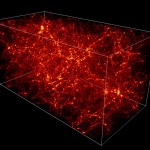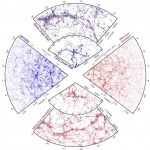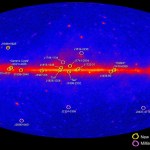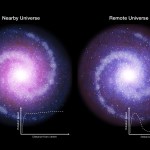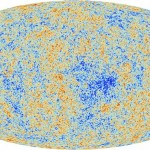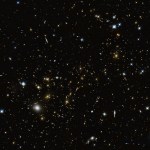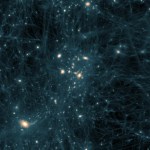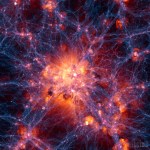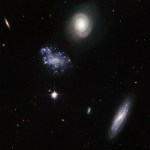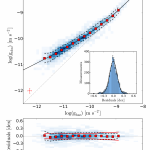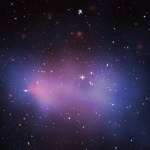Dark Matter
"Dark matter is interesting. Basically, the Universe is heavier than it should be. There's whole swathes of stuff we can't account for." -Talulah Riley
One of the most puzzling facts about the Universe is that 95% of the energy in it, in the forms of dark matter and dark energy, are completely invisible, and have never been directly detected. Perhaps, the story goes, it’s our theory of gravity that’s to blame, rather than needing new components in the Universe. While dark matter and dark energy can explain a whole slew of observations, gravity modifications do a better job of explaining…
"There are stars leaving the Milky Way, and immense gas clouds falling into it. There are turbulent plasmas writhing with X- and gamma-rays and mighty stellar explosions. There are, perhaps, places which are outside our universe. The universe is vast and awesome, and for the first time we are becoming a part of it." -Carl Sagan
It’s no secret that if we look at the matter we see in the Universe, the story doesn’t add up. On all scales, from individual galaxies to pairs, groups and clusters of galaxies, all the way up to the large-scale structure of the Universe, the matter we see is…
"Hubble often takes images of distant gravitationally lensed galaxies to infer their substructure and to try to learn about early galaxies in general. For LUVOIR, we would have that same resolution for any galaxy! That’s truly revolutionary." -John O'Meara
If you were an observational astronomer, what would your dream telescope look like? It would have to be huge, with an incredible amount of light-gathering power. The quality of the optics would have to be pristine, and higher-precision than anything ever created before. It would have to have multispectral capabilities, extending beyond both…
"Space and time may have a structure as intricate as the fauna of a rich ecosystem, but on a scale far larger than the horizon of our observations." -Martin Rees
On the largest scales, dark matter has been undoubtedly the most successful theory in modern cosmology for explaining a huge variety of observations. From the motions of galaxies in clusters to the separation of mass and light when they collide, from the correlations between galactic positions to the fluctuations in the CMB, from the bending of starlight to the formation of large-scale structure, it’s clear that the Universe needs…
"We find them smaller and fainter, in constantly increasing numbers, and we know that we are reaching into space, farther and farther, until, with the faintest nebulae that can be detected with the greatest telescopes, we arrive at the frontier of the known universe." -Edwin Hubble
When you look out at the distant Universe, you can see all sorts of things: stars, galaxies, clusters of galaxies, going as far back into the distant past as our telescopes can image. But where you have the greatest concentrations of mass, an extreme phenomenon emerges: that of gravitational lensing. Any foreground…
"Two recent studies by teams in the U.S. and the Netherlands have shown that the gamma-ray excess at the galactic center is speckled, not smooth as we would expect for a dark matter signal. Those results suggest the speckles may be due to point sources that we can’t see as individual sources..." -Eric Charles
When NASA’s Fermi satellite began operations, it didn’t take long before we had constructed the most accurate, comprehensive gamma ray map of the galaxy. While many outstanding astrophysics findings ensued, including the discovery of many new pulsars, there was one particular mystery…
"Dark matter or invisible element?
You decide." -Toba Beta
The dark matter wars rage on and on, with both sides -- those in favor of modifying gravity and those in favor of adding an additional mass component to the Universe -- claiming victories for their own side and defeat for the other. But one piece of evidence, hitherto elusive, might finally hold the key to distinguishing one from the other: early, young, less-evolved galaxies. Billions of years ago, not as much dark matter had fallen into the inner portions of galaxies, meaning that the outer portions of rotating spirals should…
“In our description of nature the purpose is not to disclose the real essence of the phenomena but only to track down, as far as possible, relations between the manifold aspects of our experience.” -Niels Bohr
When it comes to galaxies, clusters of galaxies or the largest-scales on the Universe, dark matter is absolutely required. There’s no way to explain colliding galaxy clusters, correlations between different galaxies, the filamentary structure of the Universe or the fluctuations in the Cosmic Microwave Background without it. But it isn’t just dark matter that hopes to solve these…
"For me the best answer is not in words but in measurements." -Elena Aprile
Dark matter is perhaps the most mysterious substance in the Universe. It outmasses normal matter and radiation, which includes all the known particles in the Standard Model, by a factor of 5-to-1. The observational, astrophysical evidence for its existence is overwhelming, and there are a slew of direct detection efforts underway here on Earth. Depending on dark matter’s properties, any number of them might claim success at any point in the near future.
The cryogenic setup of one of the experiments looking to exploit…
“You may hate gravity, but gravity doesn’t care.” –Clayton Christensen
If all we had were galactic rotation curves -- like those measured by Vera Rubin -- we would know that something was wrong with our picture of the Universe, but we wouldn’t know how. Two equally good explanations, that there was either a flaw in the law of gravity or there was the existence of some unseen mass, could account for what we saw. But observations of galaxy clusters point to dark matter in a dramatic fashion.
The Coma cluster of galaxies, whose galaxies move far too quickly to be accounted for by gravitation…
“The joy of life consists in the exercise of one’s energies, continual growth, constant change, the enjoyment of every new experience. To stop means simply to die. The eternal mistake of mankind is to set up an attainable ideal.” -Aleister Crowley
As we learn more and more about the Universe, we'd like to describe it as simply as possible. While we have thousands or even millions of chemical configurations, they arise from less than 100 different atoms. Atoms themselves are made up of protons, neutrons and electrons. The great hope of unification and for fans of elegance in general is that…
"Science progresses best when observations force us to alter our preconceptions." -Vera Rubin
When you look at a galaxy in the night sky, it’s easy to imagine that it’s just a system of masses like our Solar System, except on a larger scale. Instead of a single, central mass, you have many stars responsible for the galaxy’s gravitational pull. The stars revolving around the galactic center feel the tug from all the other stars and orbit accordingly, with the inner stars orbiting quickly and the outermost ones -- the ones most distant from the gravitational sources -- orbiting more slowly,…
"...axions are potentially detectable through their weak coupling to electromagnetism..." -Aaron Chou
We know, from hundreds of years of experience with the laws of physics, that momentum is strictly conserved, and therefore a reactionless drive is impossible. What's not impossible is an engine that has a reaction that's simply invisible, or otherwise undetectable to us. This has been seen in experiments involving neutrinos, but NASA's impossible space engine, the EMdrive, offers another possibility: a dark matter reaction.
Image credit: ESO/L. Calçada, of the illustration of the dark matter…
"All we know so far is what doesn't work." -Richard Feynman
The past month has seen a slew of papers out highlighting the tension between modified gravity and dark matter. Both recognize the same puzzles and problems with the Universe, and both ideas recognize that either one could be valid. In fact, if you look at the two greatest "crises" in gravity in the 19th century, it's arguable that dark matter (Neptune) solved one, the Uranus problem, while modifying gravity (with Einstein's general relativity) solved the other.
The X-ray (pink) and overall matter (blue) maps of various colliding…
“All enterprises that are entered into with indiscreet zeal may be pursued with great vigor at first, but are sure to collapse in the end.” -Tacitus
Dark matter makes up the overwhelming majority of mass in the Universe. With five times as much of it as there is normal matter, and the fact that it doesn’t emit or absorb light but does interact gravitationally, it might seem like the perfect candidate to form black holes. After all, it’s named “dark matter” to begin with, and black holes are perhaps the darkest form of matter in the whole Universe.
While stars might cluster in the disk…
"Faced with the choice between changing one's mind and proving that there is no need to do so, almost everybody gets busy on the proof." -J. K. Galbraith
Last month, tensions between dark matter simulations and galactic rotation observations reached a new high. Despite all the successes of dark matter on the largest scales -- for the CMB, for large-scale structure, for gravitational lensing and for galaxy clusters, among others -- the simplest dark matter simulations reproduced unrealistic results for how individual galaxies ought to rotate. Moreover, a team of scientists uncovered a…
"In order for the light to shine so brightly, the darkness must be present." -Francis Bacon
If you had previously thought the Universe contained a certain amount of stuff, like stars, galaxies and matter, then you might think that learning it had ten times as many galaxies might mean it had ten times as much matter. And if this were the case for matter like us, made of protons, neutrons and electrons, perhaps there wouldn’t be a need for something like dark matter, after all.
The different shapes, structures and morphologies of some of the galaxies in Hickson Compact Group 59 show evidence…
"Nothing in the standard cosmological model predicts this, and it is almost impossible to imagine how that model could be modified to explain it, without discarding the dark matter hypothesis completely." -David Merritt
Dark matter is a hugely successful theory for explaining a whole slew of observations about the Universe. Just by adding this one ingredient to the mix, we can successfully simulate and reproduce the large-scale structure, CMB fluctuations, galaxy clustering and cluster collision properties observed in our Universe. Without dark matter, there's no other way known to make…
“It may be that ultimately the search for dark matter will turn out to be the most expensive and largest null result experiment since the Michelson-Morley experiment, which failed to detect the ether.” -John Moffat
Dark matter is a puzzle that’s now more than 80 years old: the presence of all the known, observable, detectable normal matter — the stuff in the standard model — cannot account for the gravitation of the astronomical objects we observe. But despite our inability to create or detect it in a laboratory, we’re certain of its existence in the Universe.
Numerical simulation of the…
"Motions of the stars tell you how much matter there is. They don’t care what form the matter is, they just tell you that it’s there." -Pieter van Dokkum
Everything in the Universe was born with the same ratios of dark matter to normal matter: approximately 5-to-1. It shows up in everything from the cosmic microwave background to galaxy clustering to internal motions of spiral and elliptical galaxies, including the Milky Way.
From simulations and inferred maps, dark matter (blue) may form some clumps, but overall exists in a massive, diffuse halo around the luminous, disk-like part of…

